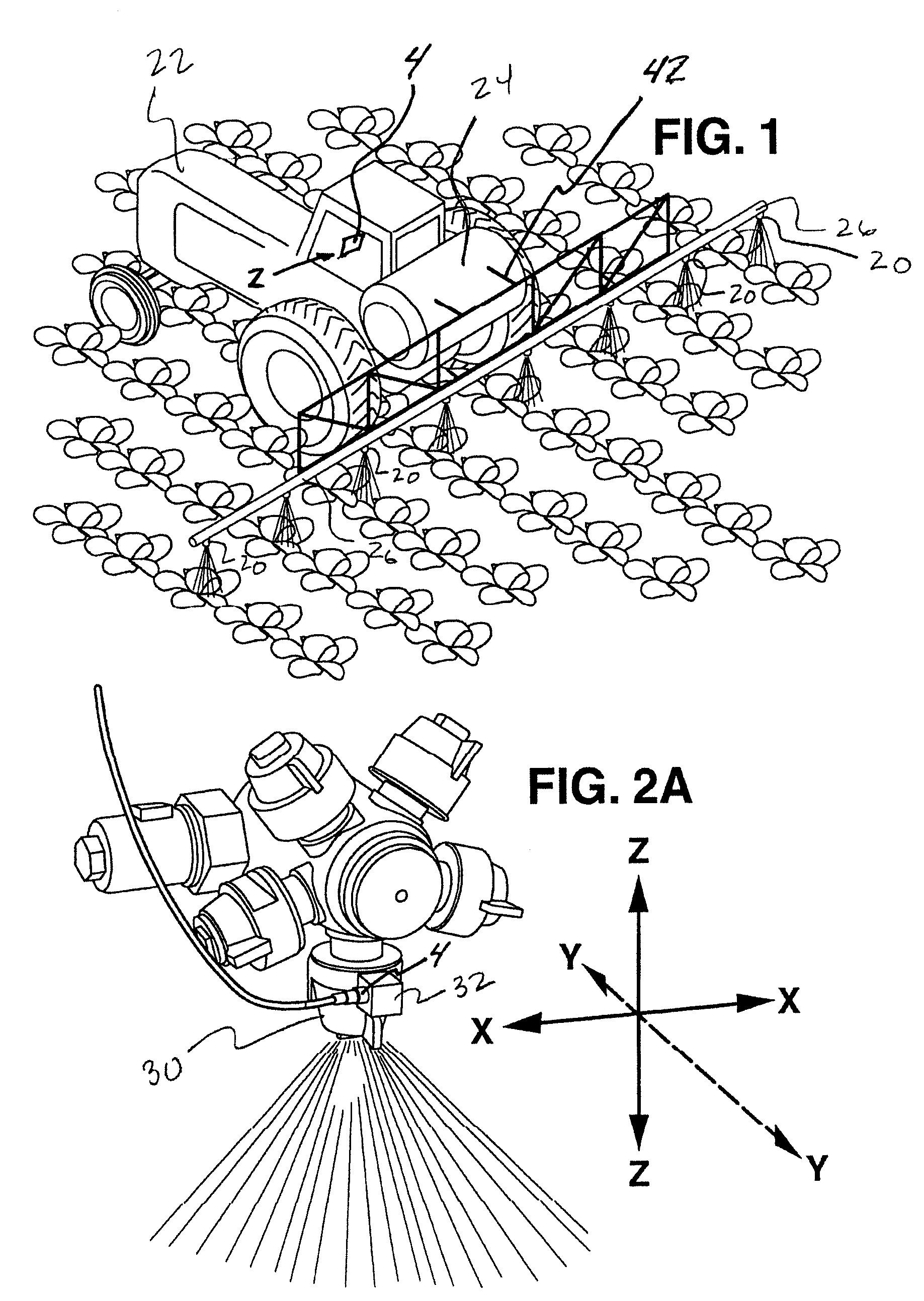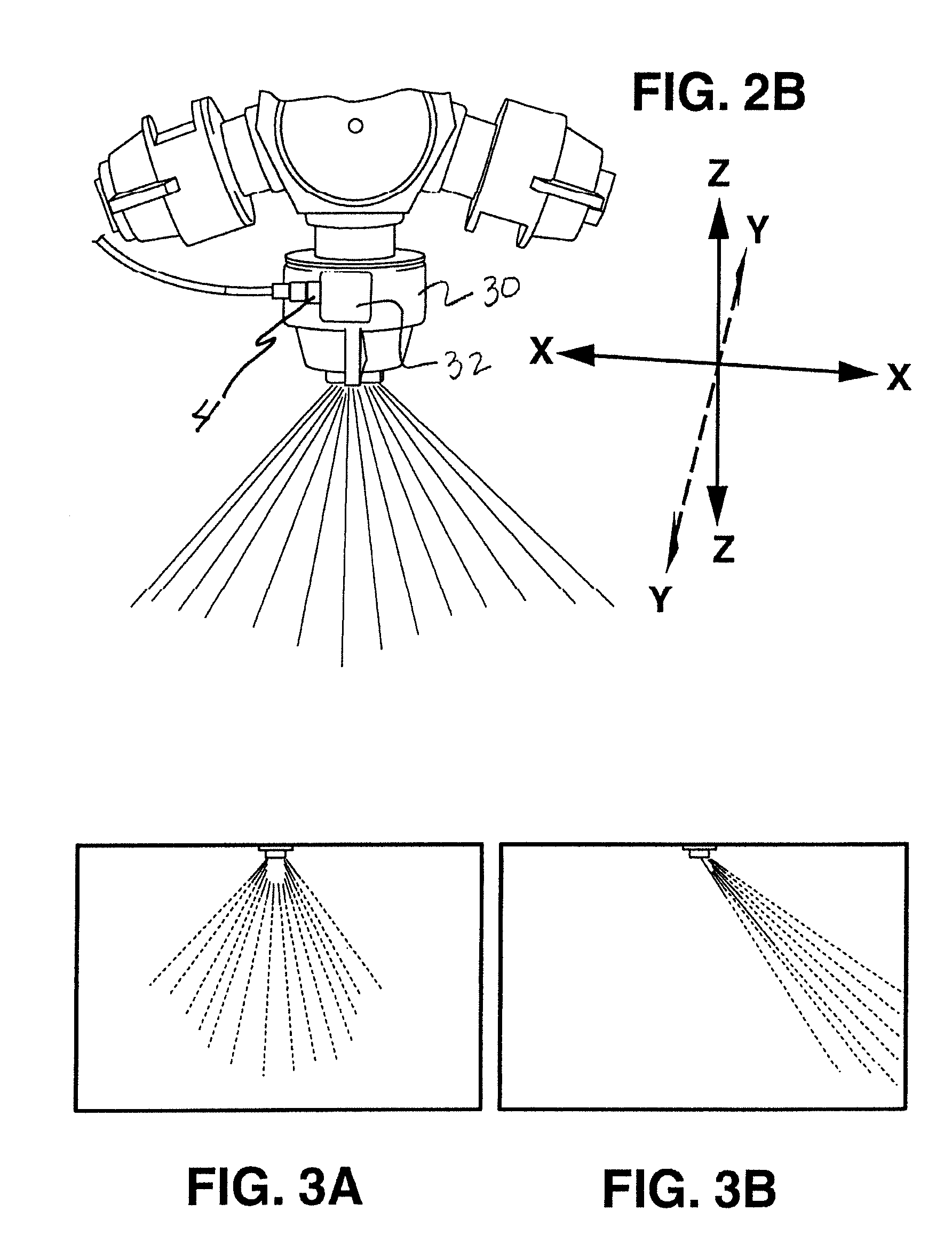Flow control and operation monitoring system for individual spray nozzles
a technology of operation monitoring and flow control, which is applied in the direction of relative volume flow measurement, vibration measurement in solids, road maintenance, etc., can solve the problems of increasing the concern of inefficient agrochemical use, the cost of agrochemicals and inadvertent spray the inability to accurately predict the effect of spraying drift or pesticide run-off,
- Summary
- Abstract
- Description
- Claims
- Application Information
AI Technical Summary
Benefits of technology
Problems solved by technology
Method used
Image
Examples
example no.1
EXAMPLE NO. 1
[0056]Characteristic vibration of the spray atomization process was investigated using a single nozzle test stand, a multiple nozzle test stand and a commercial, self-propelled field sprayer (Case 4260, CNH Global). The single nozzle test stand used air pressured canisters for liquid flow; this eliminated any vibration from pumps and bypass flow in the system. The multiple (3) nozzle test stand used an electric vane pump and allowed various configurations of pulsing flow to be generated. Data from the multiple (3) nozzle test stand were compared to the single nozzle stand. Pump and pipe flow vibrations were not found to affect the nozzle vibration measurements.
[0057]The primary instrument for data collection in these examples was an ICP triaxial accelerometer (PCB Model 356A22) with frequency response of 0.4 Hz to 6 kHz, 0.4 to 10 kHz (sensitive) and nominal output of 100 mV / g. The accelerometer was rigidly coupled to the nozzle cap using a 5-40 machine screw stud. Refe...
example no.2
EXAMPLE NO. 2
[0078]The normal and clogged nozzle tests described above addressed study of continuous spray flow. The next set of experiments addressed the measurement of pulsing flow sprays. The configuration shown in FIG. 2 was used for testing. A standard Capstan Agricultural Systems, Inc. Synchro® 12 Vdc, 7 W, direct-acting electrical solenoid valve was installed in place of the standard diaphragm check valve on the nozzle body assembly. The valve was actuated at with a square wave electrical signal at 15 Hz and a 60% duty cycle using a commercial Capstan Sharpshooter® electronic system. The asymmetry of the 60% duty cycle allowed the on and off times to be easily distinguished in data plots. During all testing, the valves on the nozzles adjacent to the test nozzle were actuated at the same frequency and duty cycle but 180° out of phase; this is identical to how the Capstan blended pulse liquid spray products are configured on field machines. Adjacent nozzle bodies were installed...
example no.3
EXAMPLE NO. 3
[0082]To demonstrate the feasibility of the present invention on an actual field sprayer, the triaxial accelerometer described above was mounted on a nozzle body on the boom of a Case 4260 self propelled sprayer with a 25 m, 54 nozzle boom and an AIM Command® pulsed flow control system. For instance, referring to FIGS. 9 and 10, the nozzle 30 is shown mounted on a spray boom 34. As also illustrated, the vibration sensor 32 is mounted onto the nozzle 30.
[0083]The system was operated at full engine throttle (2300 rpm), full pump flow for spray and agitation and with all valves (except the test location with the various nozzles installed) pulsing with 11010 nozzles (110° spray angle at 1.0 gal / min). As is done in the commercial product, alternate valves were pulsed ½ period (180°) out of phase. The field test represented a situation very close to actual spraying conditions.
[0084]Time data is shown for the X—, Y—, and Z-axis in FIGS. 11A through 11C for the system with the ...
PUM
 Login to View More
Login to View More Abstract
Description
Claims
Application Information
 Login to View More
Login to View More - R&D
- Intellectual Property
- Life Sciences
- Materials
- Tech Scout
- Unparalleled Data Quality
- Higher Quality Content
- 60% Fewer Hallucinations
Browse by: Latest US Patents, China's latest patents, Technical Efficacy Thesaurus, Application Domain, Technology Topic, Popular Technical Reports.
© 2025 PatSnap. All rights reserved.Legal|Privacy policy|Modern Slavery Act Transparency Statement|Sitemap|About US| Contact US: help@patsnap.com



